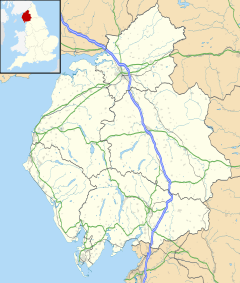Burgh by Sands facts for kids
Quick facts for kids Burgh by Sands |
|
|---|---|
| Village and parish | |
 St. Michael's Church, Burgh by Sands |
|
| Population | 1,176 (2011) |
| OS grid reference | NY326592 |
| Civil parish |
|
| Unitary authority |
|
| Ceremonial county | |
| Region | |
| Country | England |
| Sovereign state | United Kingdom |
| Post town | CARLISLE |
| Postcode district | CA5 |
| Dialling code | 01228 |
| Police | Cumbria |
| Fire | Cumbria |
| Ambulance | North West |
| EU Parliament | North West England |
| UK Parliament |
|
Burgh by Sands (pronounced 'Bruff') is a small village in Cumbria, England. It is located close to the Solway Firth, which is an estuary on the border with Scotland. This village is famous for two main historical reasons. First, it was once home to a major Roman fort called Aballava on Hadrian's Wall. Second, it is the place where King Edward I of England died in 1307.
In 2011, about 1,176 people lived in the wider area around Burgh by Sands. The village is about 11 kilometers (7 miles) west of the city of Carlisle. It has a primary school, a local pub, and a post office. There is also a special monument to King Edward I located a bit north of the village. For many years, Burgh by Sands was connected by a canal and then by a railway, making it an important transport hub.
Contents
What's in a Name?
The name 'Burgh' comes from an old English word, 'burh'. This word meant a 'fortified place', 'town', or even a 'manor house'. This name makes perfect sense because Hadrian's Wall, a famous Roman barrier, ran right through the village. The wall ended nearby at Bowness-on-Solway to the west.
A Glimpse into History
The path of Hadrian's Wall goes directly through Burgh by Sands. This shows that the village was once the site of a very important Roman fort called Aballava. It was also here that King Edward I of England passed away.
In the 1100s, the lands and Burgh by Sands Castle were owned by powerful families. Later, in the 1300s, the Dacre family took over the castle through marriage.
King Edward I of England was on his way to fight against the Scots when he became ill. He died on the marshy lands near Burgh. His body was kept in the village's old church, which was built in the 1100s. Later, his body was moved to Westminster Abbey. Today, there is a large monument built in 1685 to mark the exact spot where he died. It is about 2 kilometers (1.25 miles) north-northwest of the village and can be reached by walking.
St. Michael's Church: A Fortified Place of Worship
The Church of St Michael is a very special building. It is a fortified church, meaning it was built to be defended. The stones used to build it actually came from the old Roman wall! It stands on the site of an even older Norman church.
The church has a wide tower at its west end, which was first built around 1360. This tower was designed for defense and has a strong, arched ceiling on its ground floor. The very top of the tower was likely added in the 1700s. To get into the tower, you have to go through a special iron door called a 'yett'. This type of door was used to keep out invaders.
What makes this church truly unique is that it once had two defensive towers, one at each end! This shows how much people felt threatened by Scottish raiders in the past. The tower on the east side is now used as a small room for the clergy, but the church still doesn't have a window on its east wall. The east tower has been made lower to match the church roof, so it doesn't look like a tower from the outside anymore.
Local Government
Burgh by Sands is part of an area called the Burgh electoral ward. This ward is bigger than just the village itself. In 2011, the total population of this ward was 2,117 people.
Getting Around
Today, you can travel to Burgh by Sands by bus from Carlisle. As of September 2018, the bus service runs four times a day. In the past, the village had a railway station that connected it to other towns.
See also
 In Spanish: Burgh by Sands para niños
In Spanish: Burgh by Sands para niños




